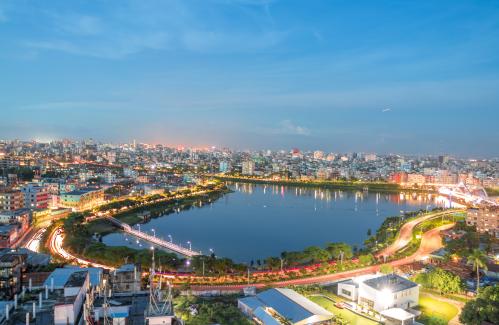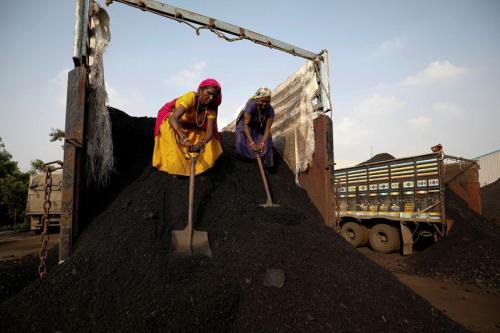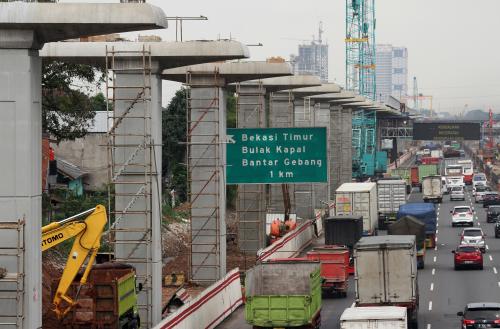Content from the Brookings Doha Center is now archived. In September 2021, after 14 years of impactful partnership, Brookings and the Brookings Doha Center announced that they were ending their affiliation. The Brookings Doha Center is now the Middle East Council on Global Affairs, a separate public policy institution based in Qatar.
One of the underlying themes of the recent developments in Ukraine is the current and future impact on energy markets. With Russia already enjoying a large share of the world hydrocarbons markets – with some 13 percent of global oil production and 20 percent of global natural gas production – a presence on the Crimean Peninsula will add further gas reserves to the country’s already unparalleled portfolio. Russia has also gained access to the Mediterranean, via the Black Sea, which is a pivotal export corridor for its hydrocarbons to both Europe and the rest of the world.
Russia supplies more than one-third of Europe’s gas demand. And current market pressure on prices may encourage Europe’s consumers to seek alternative supplies. But where will this supply come from? European producers such as Norway and the Netherlands can attempt to increase output but are unlikely to carry out significant expansions in production. Though the Middle East has huge gas reserves, most of these remain undeveloped outside of Qatar. Regional producers will need further development in pipelines to Europe to be an effective supply source, while political instability and rising demand at home raises questions about their long-term viability. Nevertheless, mounting domestic demand in the region as well as the potential for exports to Europe and Asia means that the further development of these resources is increasingly likely.
Gas markets are regional, with widely diverging prices. At the moment, the LNG price in Europe is around $9.5 per million British thermal units (Btu), rising to more than $16.5 per million Btu in the Far East, but much lower in the United States, where a vibrant spot market has helped keep prices below $5 per million Btu. Still, supply shortages in the Middle East and skyrocketing demand in Asia have put upward pressure on prices in all the regional markets. This will stimulate new developments in pipelines and transportation infrastructure to take advantage of these wide price differentials.
One new entrant to the export market is the United States, which is now turning LNG import facilities into export terminals as its unconventional supplies of shale gas continue to grow, expanding over 20 percent in the past five years. The corporations responsible for this growth are keen to seek higher profit margins through export abroad. The US export program is likely to accelerate in the forthcoming months. As a result of the crisis, US oil and gas multinationals, shareholders and US trade accounts stand to benefit from higher prices stemming from the uncertainty and turmoil in gas markets.
With a large, relatively captive market in Europe, Russia can look to the long term as it develops new markets via improved transport routes – a necessity given that oil and gas account for some 70 percent of Russia’s exports and more than 50 percent of all state revenue. Qatar, the world’s largest producer, will reap rewards from rising prices, especially if it steps up production beyond current limits. Importing nations will face higher prices, especially as the world economy recovers and demand rises.
Meanwhile, the two countries with the potential to supply the world market with more affordable gas and oil – Iran and Iraq – have been hamstrung by political barriers, be they international economic sanctions or the need to combat domestic political instability and terrorism. These two countries have the potential to increase their oil and gas production significantly: Iran has the second-largest oil reserves in the world while Iraq’s under-developed gas reserves could double with proper exploration.
Slow progress in developing these countries’ resources has benefited neighboring producers’ multinational oil companies at the expense of the world’s consumers, who have endured high and rising prices as a result.
Higher LNG prices will encourage importing nations to accelerate investment in their own unconventional sources, while seeking investment partnerships with potential suppliers such as Iran, Iraq and various North African states. China, India and the other large Asian consumers will look to the Middle East and North Africa, East Africa, Australia and Russia to secure supplies, while Japan may be keener to restart its nuclear plants to reduce dependency on expensive oil and LNG. Meanwhile, the EU will have to start hydraulic fracturing in its own backyard if it is wants to avoid paying higher gas prices in the future.
In short, current global market developments benefit gas exporters and those involved in shipping and piping gas around the world, and encourage investment in the development of gas resources in the Middle East and North Africa. The losers are European and Asian consumers who will pay higher prices for some time to come.



Commentary
Op-edMarket Pressure: The Energy Winners and Losers
May 10, 2014